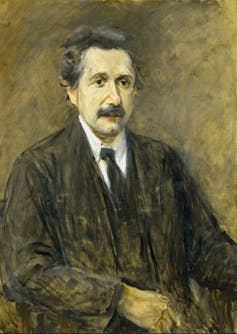Just to the left and above this sentence is a picture of me.
Like most places on the web where discussion takes place, The Conversation places a profile picture of each author next to their writing. Indeed, the web abounds with profile pictures of authors; giving the reader a chance to put a face to a name. Academics in particular are well represented with profile pictures on the web, usually on websites maintained by their faculty. Interestingly, some research I was part of shows that these pictures can tell us a lot about the academics, including which discipline they belong to and how they wish to be perceived.
Together with a wonderful cast of researchers from Flinders University and UniSA, I collected 5,829 pictures of academics from their profile pages hosted by universities around the world and recorded which side of the face was shown in the picture.
We know that the left side of the face tends to move more in the display of emotion than the right side of the face. This is because the muscles that control movements of the left and right sides of the face are stimulated by connections to the opposite hemispheres of the brain. And, the right cerebral hemisphere tends to be more involved in the perception and production of emotion than the left.
This difference in emotional display across the halves of the face leads to a bias in the way people pose for pictures. In their seminal work, researchers McManus and Humphrey showed that 60% of portraits painted since the 16th century show the left side of the sitter’s face. That is, people in general seek to show their more emotional side in pictures.
This bias has been confirmed with more recent technology which shows that people use their smart phones to take self-portraits of their left side more often than their right.
However, some people buck the trend. Previous research by psychology researcher Mike Nicholls (who was also an author on this current work) and colleagues found that in the official collection of the Royal Society, portraits of society members do not show this bias to present their more emotional side. That is, in their official portraits, scientists show themselves more in keeping with the stereotyped pose of a professional rationalist.

This made us wonder about academics from other disciplines. Do all academics want to show less emotion in their profile pictures? Or, are scientists different in the way they face the world to academics in the arts?
As a psychologist I was particularly interested in finding out the results for my own discipline. As a cognitive neuroscientist, I tend to see psychology as a science and have often engaged in light hearted arguments with my friends in social psychology about which field psychologists fit into – the humanities or sciences.
The results showed a clear difference in posing style between academics in Engineering and academics in English and Psychology with English and Psychology academics tending to show the left side of the face more than Engineers.
That academics in English and Psychology were more likely to reveal the left side of their face suggest that they are more comfortable showing their most emotional aspect to the world. On the other hand, the strictly science based Engineering academics are more keen on hiding their emotions since they were more likely to show the right side of their face. This has the effect of making Engineers appear more rational and suggests that these hard scientists seek to display themselves to the world as the unemotional clichés of popular myth.
As I went to tell my friends in social psychology that they were right: psychologists indeed face the world in a similar way to other academics in the humanities, I thought about what this all means. I am a scientist and a psychologist and I know that reason and logic play an integral role in the way I produce my work. But what motivates me is a passion for the topic and a love of discovery. So, perhaps, scientists shouldn’t be too scared of showing their emotional side. Perhaps its time to turn the other cheek.

